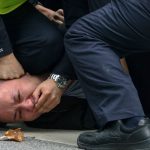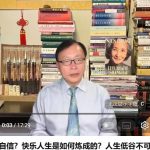2017-12-21

China‘s People Liberation Army (PLA) soldiers leap over a barrier on Tiananmen Square in central Beijing during heavy clashes with people and dissident students, June 4, 1989.
AFP
Diplomatic archives recently declassified by the U.K. government have shed further light on the horror of the military crackdown on student-led protests in Tiananmen Square, describing troops of the People’s Liberation Army (PLA) 27th army as being ordered to “spare no-one” as they used dum-dum bullets, automatic weapons and armored vehicles to carry out mass killings in Beijing.
After decades of secrecy and suppression of public debate on the massacre by the ruling Chinese Communist Party, the documents give a harrowing and bloody account of what happened on the streets of Beijing on the night of June 3, 1989 and in the days that followed, the Hong Kong news site HK01.com reported.
“On arrival at Tiananmen troops from [the northeastern province Shenyang] had separated students and residents,” then British ambassador Alan Donald wrote in a diplomatic cable dated June 1989 detailing how the Shenyang troops had been sent in unarmed to disperse the crowd, followed up by a fully armed 27th Army that rampaged through the city killing civilians and other soldiers alike.
“Students understood they were given one hour to leave square but after five minutes [armored personnel carriers] APCs attacked,” the cable said. “Students linked arms but were mown down, including soldiers.”
“APCs then ran over bodies time and time again to make “pie” and remains collected by bulldozer. Remains incinerated and then hosed down drains,” it said.
The cable, which described the 27th Army as illiterate “primitives” from the northern province of Shanxi, commanded by the nephew of then Chinese President Yang Shangkun, said the heavily armed troops were kept without news for 10 days and told they were to take part in a military exercise.
An earlier cable dated May described Beijing as encircled by at least 10 different armies from elsewhere in China, at an estimated strength of 100,000.
“The leadership keeps 27th Army on the move so that it can attack from a different direction each time,” the June cable said.
The documents also describe pitched battles between “enraged” crowds and troops in the western suburb of Muxidi, and Shilipu, to the east of the diplomatic quarter in Jianguomenwai.
“The first three waves were held by the demonstrators and [Shenyang] troops tried to push back the crowds to let 27 Army through,” the cable says. “They failed and 27 Army opened fire on the crowd (both civilians and soldiers) before running over them in their APCs.”
‘Enraged masses’
At Muxidi, “the enraged masses followed ignoring machine-gun fire to next battle at Liubukou,” the description reads, in a reference to a district of Beijing just west of Tiananmen Square.
“APCs ran over troops and civilians at 65 kilometers/hour in same manner,” it said. “One APC crashed and driver (a captain) got out and was taken by crowd to hospital. He is now deranged and demands death for his atrocities.”
It said the 27th Army was ordered to spare no-one, and “shot wounded Shenyang soldiers.”
In Liubukou, “four wounded girl students begged for their lives but were bayoneted,” it said.
“A three-year-old girl was injured but her mother was shot as she went to her aid as were six others who tried,” the cable said.
The account, which gives an estimate of 10,000 civilian deaths, suggests premeditated killings on a mass scale on the streets of Beijing.
“1,000 survivors were told they could escape via Zhengyi Lu but were then mown down by specially prepared machine-gun positions,” it says, adding that any ambulances trying to rescue the wounded were also attacked and their crews killed.
“With medical crew dead, wounded driver attempted to ram attackers but was blown to pieces with anti-tank weapon,” it says. “In further attack APCs caught up with Shenyang military reserve straggler trucks, rammed and overturned them and ran over troops.”
It said a 27th Army officer was shot dead by his own troops, “apparently because he faltered.”
“Troops explained they would be shot if they hadn’t shot officer,” according to the cable, which said the Chinese leadership was protected by two rings of tanks and armored personnel carriers, one inside the walls of Zhongnanhai, and another outside.
Target practice on civilians
The embassy said the 27th Army were likely used because they were the most “reliable and obedient,” adding that many in China believed civil war was an imminent possibility.
“Some considered other armies would attack 27 Army but they had no ammunition,” Donald’s cable reads, adding that many military reserve commanders had refused to respond to a summons to a meeting with President Yang Shangkun, while the Beijing military commander had refused to supply outside armies with food, water or barracks.
“27 Army snipers shot many civilians on balconies, street sweepers etc for target practice,” the cable says, adding that hospitals in the capital had been ordered to accept only security force casualties.
Former Tiananmen student protest leader Xiong Yan, who was a Beijing University law student at the time, said he was at at the battle of Muxidi.
“I think this is a pretty true account,” Xiong told RFA on Wednesday. “Government departments have ways of finding out military secrets, and they are more likely to have the bigger picture.”
U.S.-based former student activist Fang Zheng, who lost both legs in the crackdown, said he was at Liubukou, where he was was run over by an armored vehicle, but was more skeptical about the cables having a big impact.
“There are a lot of things about June 4, 1989 which have yet to come out,” Fang said. “If we ever get the whole truth, I think it can only come from the Chinese government.”
“But that’s unlikely to happen, because the current regime is still covering it all up and distorting the facts,” he said. “This is still the post-June 4, 1989 government in power.”
The estimate of 10,000 civilian casualties differs from later estimates of the 1989 death toll in Beijing.
Former Beijing mayor Chen Xitong told a top meeting of China’s parliament on June 30, 1989, that “more than 200” people were killed, including 36 undergraduates, while more than 3,000 non-military personnel were injured.
In 2008, victims’ group the Tiananmen Mothers, founded by retired university professor Ding Zilin, said it had documented the locations of 188 civilian deaths, 71 of whom were students, including Ding’s 17-year-old son.
But the group says that 13 of its members have yet to locate the place where their loved ones died.











